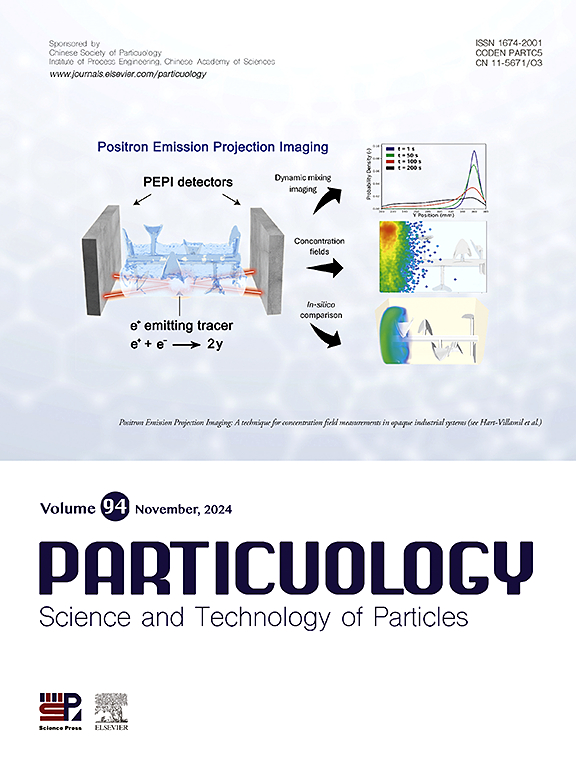Integrating multi-scale mass transfer model with discrete-DAEM to simulate the coal pyrolysis in a novel conical-type downer pyrolyzer
IF 4.3
2区 材料科学
Q2 ENGINEERING, CHEMICAL
引用次数: 0
Abstract
The performance of a novel conical-type downer pyrolyzer is carefully evaluated via numerical simulation. The study explicitly accounts for mass transfer effects by using a multi-scale mass transfer model. To achieve simultaneous high precision and computational efficiency, an enhanced strategy for calculating the multi-scale mass transfer coefficient in heterogeneous phase reaction systems is proposed by treating mass transfer and reaction as independent processes. This strategy is coupled with a discrete distributed activation energy model formulated in the Arrhenius framework. A comprehensive analysis is performed to investigate the axial distributions of key parameters, including the average concentration of solid reactants (Xs), the volatile concentration on particle surfaces (Xsf), and the volatile concentration in the bulk gas phase (Xf) under varying pyrolysis temperatures, carrier gas velocities, and solid mass fluxes. The findings reveal that Xs and Xf exhibit intuitive, monotonic trends, while Xsf demonstrates a more complex behavior, increasing due to ongoing reactions yet decreasing with mass transfer proceeding. The simulation results verify the advantages of the conical-type downer pyrolyzer, which can achieve significantly higher volatile concentrations than conventional designs.

将多尺度传质模型与离散daem相结合,模拟了一种新型锥形降叶式热解装置中煤的热解过程
通过数值模拟对一种新型锥形降灰热解装置的性能进行了详细评价。该研究通过使用多尺度传质模型明确地解释了传质效应。为了同时获得较高的计算精度和计算效率,提出了一种将传质和反应作为独立过程来计算多相反应体系多尺度传质系数的改进策略。该策略与Arrhenius框架中制定的离散分布式活化能模型相结合。综合分析了在不同热解温度、载气速度和固体质量通量条件下,固体反应物平均浓度(Xs)、颗粒表面挥发分浓度(Xsf)和散装气相挥发分浓度(Xf)等关键参数的轴向分布。结果表明,x和Xf表现出直观的单调趋势,而Xsf表现出更复杂的行为,随着反应的进行而增加,但随着传质的进行而减少。仿真结果验证了锥形降灰热解器的优点,其挥发性物质浓度明显高于常规设计。
本文章由计算机程序翻译,如有差异,请以英文原文为准。
求助全文
约1分钟内获得全文
求助全文
来源期刊

Particuology
工程技术-材料科学:综合
CiteScore
6.70
自引率
2.90%
发文量
1730
审稿时长
32 days
期刊介绍:
The word ‘particuology’ was coined to parallel the discipline for the science and technology of particles.
Particuology is an interdisciplinary journal that publishes frontier research articles and critical reviews on the discovery, formulation and engineering of particulate materials, processes and systems. It especially welcomes contributions utilising advanced theoretical, modelling and measurement methods to enable the discovery and creation of new particulate materials, and the manufacturing of functional particulate-based products, such as sensors.
Papers are handled by Thematic Editors who oversee contributions from specific subject fields. These fields are classified into: Particle Synthesis and Modification; Particle Characterization and Measurement; Granular Systems and Bulk Solids Technology; Fluidization and Particle-Fluid Systems; Aerosols; and Applications of Particle Technology.
Key topics concerning the creation and processing of particulates include:
-Modelling and simulation of particle formation, collective behaviour of particles and systems for particle production over a broad spectrum of length scales
-Mining of experimental data for particle synthesis and surface properties to facilitate the creation of new materials and processes
-Particle design and preparation including controlled response and sensing functionalities in formation, delivery systems and biological systems, etc.
-Experimental and computational methods for visualization and analysis of particulate system.
These topics are broadly relevant to the production of materials, pharmaceuticals and food, and to the conversion of energy resources to fuels and protection of the environment.
 求助内容:
求助内容: 应助结果提醒方式:
应助结果提醒方式:


